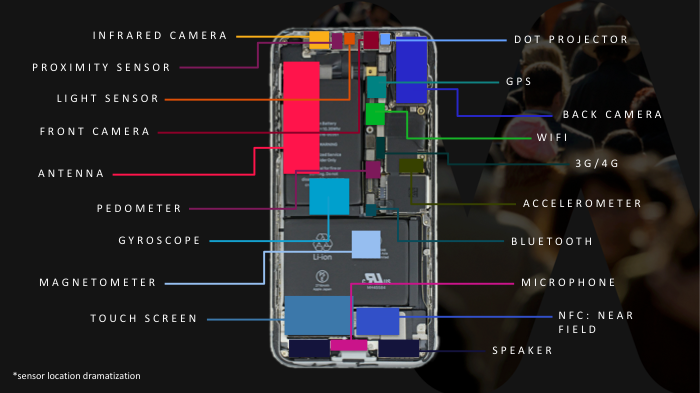Mobile: Principles of creative best practice
-
Principle 1. Take advantage of the technology within the smartphone
-
Principle 5. Think about bespoke mobile creative; don't just cut and paste ads from other platforms
Principle 1. Take advantage of the technology within the smartphone
Rowan Newman, Head of Creative, Weve
The unique technology our phones possess sets mobile apart from any other media. It’s the reason we can make calls, take photos and pay for a coffee without ever reaching for our wallets. Ultimately, it’s the reason our phones have become such an integral part of our daily lives.
The potential for this in-built functionality to create powerful mobile creative should not be ignored. In fact, some brands have found a ten-times higher engagement rate on campaigns that utilise these unique features, which could include anything from the gyroscope, light sensor and accelerometer through to the camera, microphone and touchscreen.
Advertisers can use these sensors to make existing ads feel more mobile-friendly, but most importantly these unique features should be considered from the start and used to power creative ideas. In doing so brands have the opportunity to create rich, immersive ads that are more akin to the engaging experiences we have come to know and love on our phones.
Principle 2. Keep it simple!
Dominic Tillson, Head of Insight, Inskin
The mobile is a very personal screen, with limited real estate for advertisers. It’s important to remember that visitors of a website aren’t there to see ads, but to consume content.
It is possible to make users positively engage with your brand with the right techniques, as long as you ensure you keep messaging, branding and call to actions as clear and simple as possible.
Animation attracts attention, text retains it, so lead with animated imagery to direct the user’s attention. Copy should be kept short and punchy for greater message impact, and the number of different messages should be limited. Imagine your message is a tennis ball – throw one to a friend and they’ll catch it, throw 4 and they will probably drop them all.
Making use of haptic and native experiences can drive interaction, while tapping into the phones accelerometer to deliver user-controlled animations can increase engagement.
Also consider your users’ data consumption and user experience – lighter, simpler creatives will load quicker and have a more positive impact.
Principle 3. Consider the location of the audience
George Dixon, Head of Product and Strategy, Mobsta
The nature of mobile advertising is that you can reach someone in absolutely any location. Advertisers need to consider this when planning their campaigns. Here’s three tips for success:
1. Play to a formats strength
- Native – Delivering directional messaging when in proximity to store driving spontaneous visits.
- Banner – Offering interaction and further content. Ideal post exposure to an offline channel like OOH (Out-of-Home), combining both channels awareness to maximise effect.
- MPU – Showcasing new products or new offers, keeping a product top of mind at a key moment (such as near a relevant location).
2. Keep to simple rules when designing
- Quick. Keep your frames to a maximum of 3-4 - With an overall timeline of 8 seconds.
- Visible. The brand should be visible from the start - With a clear call to action.
- Light. Be considerate of load time - Only expand if further content adds value.
3. Footfall related messaging needs to be direct and dynamic, keep it simple directing the audience to store
- Relevance. Combine location related targeting with simple relevant messaging based on past location behaviour.
- Signpost. The simplest way to drive a visit is signpost the nearest destination.
- Dynamic. ‘distance to’ dynamic creative elements can improve visits up to 3x.
Principle 4. Keep the creative file size light weight
Katy Eckersley, VP Sales & Propositions, Rezonence
User experience should be at the heart of every publisher page and the ads on them are critical to this. The experience on mobile in particular is crucial due to smaller screens and phone data at risk of being used without user consent. Although ads may load perfectly well and look great in a review environment, when placed out in “the wild” they are often one of several similar ads on the page, all competing for attention and bandwidth to load. Multiple layered images or video files slow down page load times, with display banners often on loop for several seconds. With the average “in view” time on these at around 3 seconds, consider whether your message can land in lighter static image files. Building in HTML5 helps this (rather than flash), by creating a better user experience and ensuring the value exchange is transparent and fair.
Principle 5. Think about bespoke mobile creative; don't just cut and paste ads from other platforms
Rowan Newman, Head of Creative, Weve
Mobile is unique and requires a device-first approach to creative. The IAB UK Fit for Purpose research found 78% of consumers are annoyed by ads that are not optimised to the device they are using.
In fact, people would rather see more ads that are designed well for mobile versus less that were poorly designed. This speaks volumes about the importance of made-for-mobile creative in a world with an increasing appetite to ad-block.
There are a number of things that can be done to optimise creative for mobile. For example:
- Keep the most important components, like the logo and call-to-action, clear and present at all times.
- Build the ad using responsive design to cater for the wide variety of device screen sizes.
- Remember less is more; when it comes to copy and content keep it simple.
- Consider using crops of products rather than full images that can be harder to see on a small screen.
When ads are designed with mobile in mind they can have a positive impact on customers’ perceptions of quality and trust in a brand. Adopting some of these principles will help advertisers to take advantage of this in the future.
A best practice case study can be found here.
Contributors




Topics
Related content
Google introduces Privacy Sandbox for Android
Learn moreConsumer control and “common sense” key to tackling mobile ad blocking: IAB UK study
Learn moreNative distribution: Principles for creative best practice
Learn moreIAB UK bids farewell to flagship Mobile Engage event
Learn more
Fast forward to 2030 with Futurescape
An in-depth exploration of the attitudes, innovations and media shifts that will shape the years ahead and redefine how we advertise by the turn of the decade




